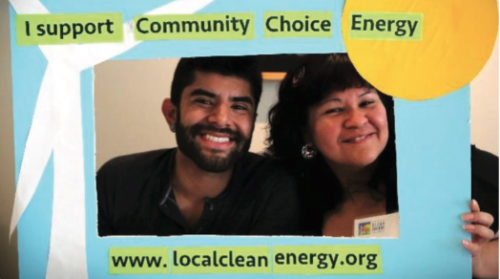When people buy a new home in a different city, they’re typically given the phone number of the investor-owned utility (IOU) that will serve them. They know they must call this one provider, supply payment information and set up service if they want the lights to turn on in their new home.
But in seven states, homeowners could instead have a menu of different local, green energy options to choose from instead of one IOU.
This localized energy initiative is called community choice aggregation or CCA (which media outlets abbreviate for brevity, although community choice energy advocate and coordinator of the California Alliance for Community Energy Al Weinrub said, “We never refer to it as ‘CCA,’ as the words are very powerful and the abbreviation is very mysterious.”)
CCAs are growing, especially in California. The California Community Choice Association (CalCCA) announced in November that CCAs in the state have signed long-term contracts with new renewable energy facilities totaling more than 2 GW, “reflecting a strong commitment by CCAs to drive clean energy and economic development in California and help the state achieve ambitious decarbonization and climate change goals,” according to a CalCCA press release.
Community choice aggregation means putting the power in the public’s hands—literally and figuratively. CCA legislation allows cities and counties within IOU service territories to provide electric service to customers.
A public agency takes over the job of electric procurement from IOUs, while the IOUs still play the important role of electric distribution. This gives consumers more choices for their energy footprint—and in places that do it right, those choices can be both greener and cheaper.
“The beauty of a community choice law is to allow for public control of all the important aspects of electricity, while not having to worry about taking over the infrastructure which is often old and outdated,” Weinrub said.
CCAs can be great vehicles to accelerate the growth of renewables in communities. They can encourage more local development of solar by smaller companies, keeping economic growth and jobs close to home.
How a CCA works
Community choice legislation must be passed at the state level in order to require state IOUs to cooperate with the formation of CCAs.
After CCA legislation is passed at the state level, each city or county in the state can form its own CCA as a local ordinance. Once the ordinance is passed, an agency must be formed to create and manage the CCA.
“It could be housed within a city or a county government, but more of what we’ve seen is they’re set up as a joint powers authority so that they create a new agency altogether to run the program,” Weinrub said.
CCAs have to compete with IOUs, so the energy they procure must either be the same price or cheaper than the IOU’s rate, or come with other benefits like more local renewables or other energy justice initiatives.
For CCAs to be successful, they must be set up as opt-out programs. That means consumers in an area where a CCA is set up are automatically enrolled in the program instead of automatically enrolled with the regional IOU. Typically, CCAs have different levels to choose from, so the overseeing agency would decide which level would be the default, and then consumers can choose to stay at that level, change their rate plans to another level or enroll back with the IOU.
Katie Davis, chair of the Santa Barbara, California, chapter of the Sierra Club, said Ventura County actually set its CCA default level as 100% renewable energy. The program launches in 2019. Since the desert is nearby, with ample land for solar development, the renewable level is not much more expensive than a Southern California Edison utility bill—only 7 to 9% more, and less expensive than SCE’s current “green tier.”
If residents don’t want their bills to go up that 7 to 9%, they can choose to drop down to the 50% renewable energy tier offered by the CCA, which is cheaper. But Davis doesn’t think many people will mind paying a little more for all-renewable energy, since a recent California poll found most people want to see action on climate change even if it costs more.
“We do have to accelerate a transition to renewable energy,” Davis said. “The solution and the mixture of energy sources is going to be different in different places, and we all have to figure that out on a local level.”
CCAs help solar
Weinrub said CCAs are great vehicles for spurring development of smaller-scale community-based solar power, usually between a couple hundred kilowatts and 1 or 2 MW. Even the IOUs investing in solar are typically doing so in the form of multi-megawatt, utility-scale farms, often installed by large, out-of-state companies. These smaller CCA solar jobs can be sited within the community and installed by local solar companies instead of national solar heavyweights.
“Community choice offers the possibility of a lot of more local development and much more use of the built environment to develop solar, as opposed to either converting farmlands or sensitive ecosystems,” Weinrub said.
Smaller-scale farms cost more per watt than larger utility-scale installations, but Weinrub said the local benefits of economic growth and jobs outweigh that downside.
CCAs can also integrate other innovative solar programs, like solar group buys and community shared solar installations, to increase solar production in a region. If a CCA launches a Solarize effort, the CCA agency could then act as the administrator of the group buy, doing the upfront work to determine which homes might be suitable for solar and educating the community on the benefits of solar power.
“A lot of that risk is taken off of the individual parties and it makes the whole job in the long run cheaper than it would have been, so that’s another kind of win-win that can come from having a stronger public role in the development of solar in the community,” Weinrub said.
CCAs can also use progressive green job programs to install these local projects. California’s first CCA, called MCE, used some workers from the RichmondBUILD Academy to install its 10.5-MW MCE Solar One array. RichmondBUILD is a public-private partnership in the city of Richmond, California, focused on developing talent for underserved communities in high-wage construction and renewable energy fields.
The conflict
Although CCAs need IOUs in order to exist and distribute the energy they procure, IOUs often see their relationship with CCAs as less symbiotic and more antagonistic.
“In the early days, the community choice, these programs, were vehemently opposed by the investor-owned utilities,” Weinrub said. “They still are vehemently opposing them, but they’ve used different tactics.”
CCAs compete with IOUs for procurement, so it makes sense that IOUs often fight against them. One strategy IOUs used to try to kill CCAs in California was to make them opt-in programs instead of opt-out.
“It was good public relations because they said, ‘Community choice is hostile to the community because it’s already enrolling people in a program without permission,’ which was clever, but they never mentioned that that’s what happened originally as well,” Weinrub said.
CCAs must be opt-out programs because they have to know what their customer base is from the start so they know how much energy must be procured. If it’s an opt-in style, CCAs could spend all their time and money on marketing enrollment and not have enough funds leftover for the actual energy procurement.
CCA advocates won that opt-out battle against IOUs in 2014, and Weinrub said that win accelerated CCA growth statewide. But IOUs continue to fight against CCAs and sometimes win, most recently when the California PUC voted to raise the cost of monthly “exit fees” customers must pay IOUs if they choose to switch to a CCA.
Programs vary
CCAs don’t inherently procure green power—it all depends on the community desires and who is in charge of the program.
“If you look at the other 19 community choice programs in California, there’s quite a spectrum of the extent to which some are just acting like the regular investor-owned utilities, just out buying and selling electricity, and others which have much more of a social program associated with them,” Weinrub said.

SOPEC received a Bronze designation from the national SolSmart program for making it faster, easier and more affordable for homes and businesses to go solar. Credit: Ohio University/ Photo by Ben Siegel
Ohio is one state that passed CCA legislation in 1999. Athens, Ohio, county commissioner Chris Chmiel was elected in 2012, a year when fracking natural gas was poised to boom in his county. Chmiel said Athens County is split between environmentally minded residents as well as residents in extreme poverty. Some citizens deeply opposed fracking while others welcomed the new opportunity to make money on gas.
“Walking that fine line between these two extremes prompted me to try and approach energy in a broader and more proactive way,” Chmiel said. “This is when I basically learned about CCAs.”
The County Commissioners Association of Ohio has a program that helps communities get CCA ordinances on the ballot and passed. Chmiel worked with the group to successfully create a CCA for Athens County, the City of Athens and the Village of Amesville called SOPEC.
SOPEC worked out a deal with the local IOU, AEP Ohio, to offer 26% savings from the cost to compare at the time, but at the same time, the marketplace was heading toward auctions and the deal didn’t turn out to be that great, Chmiel said. He hasn’t abandoned hope for the CCA but sees a need for “possible statewide policy changes that will ensure that CCA programs truly benefit the citizens they serve.”
SOPEC executive director Eddie Smith added that a major hurdle with starting a CCA was consumer misunderstanding about energy markets. Smith said communities often believe that “bulk purchasing” through a CCA achieves a lower energy supply rate for customers, but that’s not necessarily true. Smith said the energy market works similarly to the health insurance market, with CCA programs determining the expected cost of energy by examining the underlying risks of the aggregated group. Those risks are determined by looking at historic usage data, weather data and other unique figures for each customer like load factor and peak load contribution.
However, Smith praised CCAs for their ability to create real local policy benefits for communities. CCA programs like SOPEC can help communities with the programming needed to increase renewable penetration and energy efficiency measures. For example, communities can institute carbon pricing at the local level, and increase the CCA program rate deliberately to account for some of the cost of carbon emissions. That extra revenue can then be used to decrease the cost of solar for the public sector.
“Using CCA as a local policy mechanism does not create an administrative burden on the utility company or require an agreement with the utility,” Smith said. “The ball is entirely in the local government’s court. There’s really no other public programming in Ohio that has so much local autonomy for impacting public policy with regard to sustainable energy.”
Putting energy procurement in public hands holds a lot of promise for renewable growth and solar contractors. Installers should advocate for CCA legislation at the state level and then work in their communities to launch CCA programs that build more local, clean energy and local, green jobs.












Tell Us What You Think!